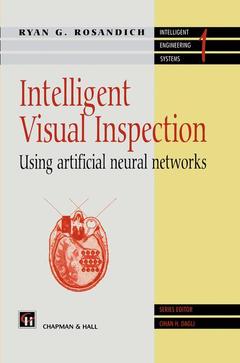Description
Intelligent Visual Inspection, 1997
Using artificial neural networks
Intelligent Engineering Systems Series
Author: Rosandich R.
Language: English
Approximative price 210.99 €
In Print (Delivery period: 15 days).
Add to cart
Publication date: 01-2013
306 p. · 15.5x23.5 cm · Paperback
306 p. · 15.5x23.5 cm · Paperback
Description
/li>Contents
/li>Comment
/li>
A great deal of research is being done in the areas of artificial vision and neural networks. Although much of this research has been theoretical in nature, many of the techniques developed through these efforts are now mature enough for use in practical applications. Automated Visual Inspection Using Artificial Neural Networks explains the application of recently emerging technology in the areas of artificial vision and neural networks to automated visual inspection. The information is organised in a clear, informative manner, bridging the gap between theoretical research and practical application. Significantly this book includes: * broad coverage of all aspects of the automated visual inspection problem, * details of the HAVENET neural network and the CAMERA vision model, and * detailed descriptions of practical applications of intelligent visual inspection.
One: Introduction.- 1. Intelligent manufacturing.- 1.1 Introduction.- 1.2 Definition of intelligence.- 1.3 Role of vision in intelligence.- 1.4 Modem manufacturing systems.- 1.5 Considerations in intelligent manufacturing systems design.- 2. Intelligent visual inspection.- 2.1 Vision systems for intelligent manufacturing.- 2.2 Definition of visual inspection.- 2.3 Objectives of visual inspection.- 2.4 Inspection errors.- 2.5 Categories of inspection.- 2.6 Areas of application for visual inspection.- 2.7 Benefits of automated inspection.- 2.8 Commercially applied inspection systems.- 2.9 Limitations of automated visual inspection.- 2.10 Research goals.- Two: Fundamentals of Artificial Vision Systems.- 3. Biological vision systems.- 3.1 Introduction.- 3.2 Basic physiology of vision systems.- 3.3 Human visual cognition.- 3.4 Object recognition.- 3.5 Summary.- 4. Artificial neural networks for pattern recognition.- 4.1 Introduction.- 4.2 Early artificial neural networks.- 4.3 Backpropagation neural networks.- 4.4 Self-organizing maps.- 4.5 Adaptive resonance theory and its derivatives.- 4.6 Neocognitron neural network.- 4.7 HAVNET neural network.- 4.8 Summary.- Three: Artificial Vision Systems Design.- 5. Image acquisition and storage.- 5.1 Introduction.- 5.2 Cameras.- 5.3 Object lighting and presentation.- 5.4 Image acquisition cards.- 5.5 Image processing hardware.- 5.6 Image formats.- 6.6 Low-level image processing.- 6.1 Introduction.- 6.2 Image size reduction.- 6.3 Noise removal and filtering.- 6.4 Thresholding and histograms.- 6.5 Region growing and hole filling.- 6.6 Edge detection.- 6.7 Primitive image features.- 6.8 Summary.- 7. Intermediate image processing.- 7.1 Introduction.- 7.2 Color representation and processing.- 7.3 Shape from shading.- 7.4 Stereo vision.- 7.5 Analysis of visual motion.- 7.6 Grouping primitive features into complex features.- 7.7 Summary.- 8. Computational approach to artificial vision.- 8.1 Introduction.- 8.2 The work of David Marr.- 8.3 ACRONYM vision system.- 8.4 SCERPO vision system.- 8.5 Recognition by components theory and the PARVO vision system.- 8.6 Summary.- 9. Connectionist approach to artificial vision.- 9.1 Introduction.- 9.2 Grossberg vision model.- 9.3 Seibert-Waxman vision model.- 9.4 CAMERA vision model.- 10. Experimental evaluation of the CAMERA vision model.- 10.1 Introduction.- 10.2 Experimental apparatus and conditions.- 10.3 Recognition of simple two-dimensional objects.- 10.4 Recognition of complex two-dimensional objects.- 10.5 Recognition of three-dimensional objects.- 10.6 Recognition accuracy.- 10.7 Recognition time.- 10.8 Summary of CAMERA evaluation.- Four: Case Studies.- 11. Automated visual inspection systems.- 11.1 Introduction.- 11.2 Inspection of polished silicon wafers.- 11.3 Inspection of pharmaceutical blister packages.- 11.4 Summary.- 12. Future of automated visual inspection.- 12.1 Introduction.- 12.2 Proposed flexible manufacturing system.- 12.3 Challenging visual inspection problem.- 12.4 Summary.- Appendix A.- Appendix B.- References.
The book explains the application of recently emerging technology in the areas of artificial vision and neural networks to automated visual inspection. The information is organized in a clear, informative manner, bridging the gap between theoretical research and practical application. Coverage includes the definition of the inspection problem, identification of current weaknesses in automated visual inspection systems, and the application of new techniques to address these shortcomings.
© 2024 LAVOISIER S.A.S.




